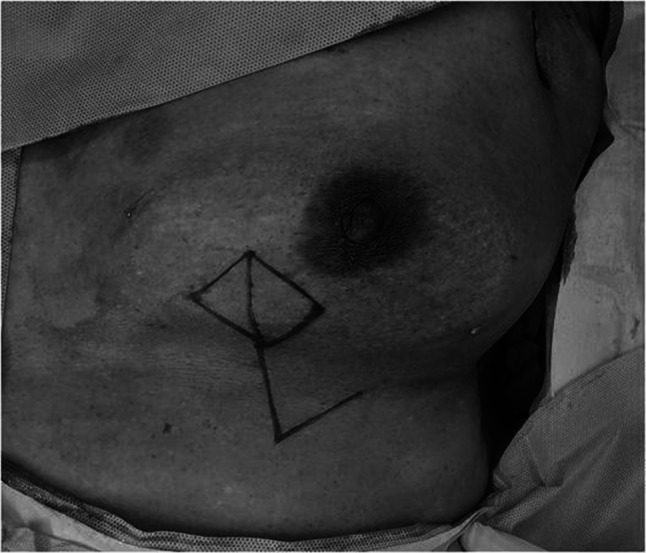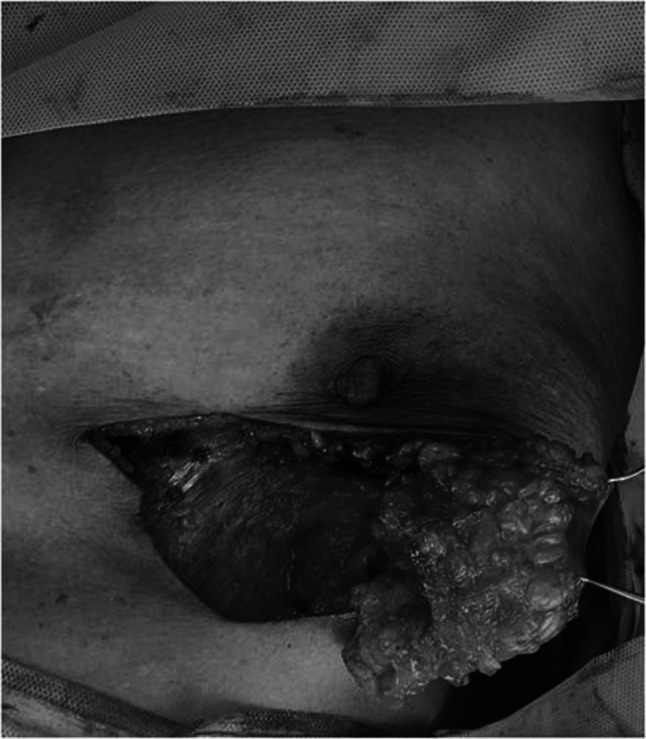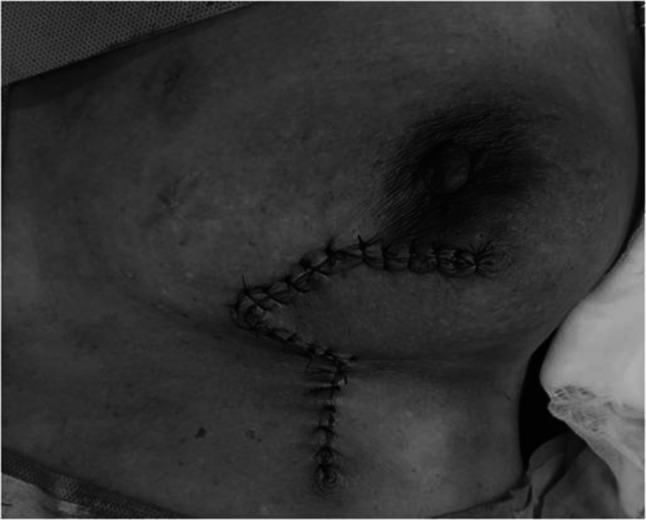Abstract
Limberg flap is currently not commonly used in breast oncoplasty. We present our experience with Limberg flap reconstruction in breast cancer patients who underwent breast conservation surgery. This study was conducted at a tertiary cancer centre in Kerala, India. We reviewed the records of patients with breast cancer who underwent Limberg flap reconstruction with breast conservation surgery from 1st January 2020 to 31st October 2021. Data collected included age, quadrant of tumour, side of tumour, T and N stage, status at surgery (primary or post neoadjuvant therapy), type of surgery, flap complications following surgery and breast deformity following surgery. Seventeen patients underwent Limberg flap reconstruction during the study period. The median age of the patients was 51 years. The commonest stage was cT1N0M0. Twelve patients underwent primary surgery and 5 post neoadjuvant chemotherapy. No patient had postoperative flap complications or breast deformity. Limberg flap is simple, versatile and robust and should be a part of the armamentarium of breast surgeons.
Keywords: Breast cancer, Breast conservation surgery, Limberg flap, Oncoplasty
Introduction
Breast conservation surgery is the current gold standard in the treatment of breast cancer whenever feasible. In this surgery, the oncological safety and cosmesis go hand in hand. Breast oncoplasty procedures play an important role in breast reconstruction combining principles of oncology and plastic surgery. Oncoplasty includes both volume displacement and volume replacement procedures. Most commonly used technique of volume replacement in current practice is the perforator flap. Perforator flaps give excellent cosmesis but are complex and rarely undergo partial or complete necrosis. A local flap can replace a tissue defect functionally and cosmetically. The Limberg flap also known as rhomboid flap or rhombic flap one of the most commonly used local flaps [1]. It is a random-pattern local flap that relies on blood supply through the subdermal plexus. It is a useful technique that is simple for surgeons to design and perform. Limberg flap is commonly used in head and neck and pilonidal sinus reconstruction [2–4]. Earlier literature in breast conservation surgery with Limberg flap reconstruction consisted of large series of 200 cases [5]. However, with the advent and popularity of type 1 and 2 oncoplasty and perforator flaps, Limberg flap is currently not widely used in breast reconstruction. Current literature on Limberg flap in breast reconstruction is limited and restricted to case reports in an attempt to rejuvenate the flap [6–8].
In the lower quadrants of the breast, excision of the tumor without reconstruction can result in bird’s beak deformity [9]. Volume replacement using the robust and versatile Limberg flap results in excellent cosmesis with minimal morbidity as compared to other oncoplasty. Limberg flap technique is especially useful in lesions near the inframammary crease with close proximity to the skin. This study is a review of our experience with Limberg flap in breast conservation surgery.
Material and Methods
This retrospective review was conducted at a tertiary cancer center after receiving clearance from the institutional review board. Data was collected of women who underwent Limberg flap reconstruction during breast conservation surgery from 1st January 2020 to 31st October 2021. Data collected included age, quadrant of tumor, side of tumor, T and N stage, status at surgery (primary or post neoadjuvant therapy), type of surgery, flap complications, and breast deformity following surgery. The primary site of tumor was tattooed in patients receiving neoadjuvant chemotherapy. The data was analyzed and is presented descriptively.The flap planning is depicted in Fig. 1. A rhomboid defect was created during the excision of the tumor with adequate margins such that the shorter diameter was in the craniocaudal direction. This diameter was extended equal to its length towards the inframammary crease and the remaining limb was drawn parallel to one of the lower sides of the rhombus. The defect after excision of tumor and the elevated flap are depicted in Fig. 2. The cosmesis on the first postoperative day is depicted in Fig. 3 and the long-term post-radiotherapy cosmesis is depicted in Fig. 4.
Fig. 1.

Design of the Limberg flap
Fig. 2.

Breast defect after excision of tumor with the elevated Limberg flap
Fig. 3.

Postoperative day 1 cosmesis following the Limberg flap
Fig. 4.

Post radiotherapy follow up of the Limberg flap
Results
Seventeen women underwent breast conservation surgery with Limberg flap reconstruction during the study period. The patient, tumor, surgery characteristics and the postoperative outcomes are depicted in Table 1. The median age of the women was 49 years. The tumor was located in the lower inner quadrant in the 14 patients and lower outer quadrant in 3 patients. The commonest stage at presentation was cT1N0M0. Twelve patients underwent primary surgery and 5 patients underwent surgery post neoadjuvant chemotherapy. Sentinel lymph node biopsy was done using blue dye technique in 9 patients. No patient had any postoperative flap complications or breast deformity in immediate postoperative period. The margins of excision of the primary tumor was negative in all the cases.
Table 1.
Patient, tumor, surgery characteristics and postoperative outcomes
| Serial number | Age years | Side of tumour | Quadrant | cTNM stage | cT cm | Status at surgery | Surgery | pT cm | Flap complications | Breast deformity |
|---|---|---|---|---|---|---|---|---|---|---|
| 1 | 42 | left | Lower inner | T1N0M0 | 2 | primary | BCS(SLNB)* | 1.8 | Nil | Nil |
| 2 | 64 | left | Lower outer | T2N1M0 | 4.5 | primary | BCS# | 4.2 | Nil | Nil |
| 3 | 47 | left | Lower inner | T1N0M0 | 2 | primary | BCS(SLNB)* | 1.3 | Nil | Nil |
| 4 | 51 | left | Lower inner | T1N2M0 | 2 | Post NACT+ | BCS# | 1.9 | Nil | Nil |
| 5 | 44 | right | Lower inner | T2N0M0 | 4 | primary | BCS(SLNB)* | 3.5 | Nil | Nil |
| 6 | 51 | left | Lower inner | T1N0M0 | 2 | primary | BCS(SLNB)* | 1.6 | Nil | Nil |
| 7 | 64 | left | Lower inner | T1N1M0 | 1.5 | primary | BCS# | 1 | Nil | Nil |
| 8 | 68 | left | Lower inner | T1N1M0 | 1 | Primary | BCS# | 1.3 | Nil | Nil |
| 9 | 59 | right | Lower inner | T2N2M0 | 3 | Post NACT+ | BCS# | 2.8 | Nil | Nil |
| 10 | 31 | right | Lower outer | T1N2M0 | 2 | Post NACT+ | BCS# | 0.8 | Nil | Nil |
| 11 | 59 | left | Lower inner | T2N1M0 | 4 | Post NACT+ | BCS# | 2 | Nil | Nil |
| 12 | 51 | right | Lower inner | T1N0M0 | 1.5 | Primary | BCS(SLNB)* | 1.1 | Nil | Nil |
| 13 | 50 | right | Lower outer | T2N0M0 | 3.5 | Primary | BCS(SLNB)* | 3.3 | Nil | Nil |
| 14 | 36 | left | Lower inner | T1N0M0 | 1.5 | Primary | BCS(SLNB)* | 1.1 | Nil | Nil |
| 15 | 59 | left | Lower inner | T2N0M0 | 2.5 | Primary | BCS(SLNB)* | 2.8 | Nil | Nil |
| 16 | 55 | left | Lower inner | T1N0M0 | 2 | Primary | BCS(SLNB)* | 1.6 | Nil | Nil |
| 17 | 56 | Left | Lower inner | T2N2M0 | 4 | Post NACT+ | BCS# | 3.8 | Nil | Nil |
Post NACT+, post neoadjuvant chemotherapy; BCS (SLNB)*, breast conservation surgery with sentinel lymph node biopsy; BCS#, breast conservation surgery
Discussion
Russian surgeon Alexander Limberg first illustrated the rhomboid flap in 1945 and published it in English in 1966 [10]. This flap is a random transposition flap which requires a quadrilateral rhombus-shaped defect. In our cases, we utilized the fasciocutaneous tissue below the inframammary crease to create the Limberg flap. Breast conservation surgery in tumors of the lower quadrants may result in bird beak deformity. Many types of oncoplasty such as inverted T technique, J plasty, V plasty, and superior pedicle oncoplasty have been described for this region [9]. The common perforator flaps used in this region are based on the intercostal artery perforators such as AICAP (Anterior InterCostal Artery Perforator) and LICAP (Lateral InterCostal Artery Perforator) flaps [11]. These flaps are complex and time-consuming. The Limberg flap is a simple, versatile, robust, and is especially useful in lesions close to the inframammary crease. It is also useful in cases with skin loss during excision. The inframammary crease is reformed and gives very good cosmesis as depicted in Figs. 3 and 4. None of the patients had any flap complications. This is due to the robust design of the flap. In the large series by Silva et al., 45% of the tumors were in the lower quadrant [5].
This flap design can be used in any of the breast quadrants. However, there are simple oncoplasty techniques available for the other quadrants which will provide equivalent if not better cosmesis. In the lower quadrants, the oncoplasty would result in loss of ptosis. This would result in disparity between the two breasts as our patients are rarely willing for any reduction procedure in the opposite breast. Mokkapati et al., in their study on the breast anthropometry in Indian women concluded that nearly 81% of patients had ptosis and up to 40% had grade 3 ptosis [12]. This flap is more useful in ptotic breast with small defects. In non-ptotic breasts, oncoplasty and in larger lesions, intercostal perforator flaps or inverted T oncoplasty or J plasty would be a better option. Inverted T oncoplasty or J plasty are volume displacement techniques which can be carried out if there is adequate volume in the lower half of the breast to replace the excision volume. In ptotic breasts. these techniques reduce the ptosis on the operated side and cause disparity between the two breasts. A reduction mammoplasty may be required in the opposite side for symmetrization which may not be practically possible in low resource high volume centers and also due to patient’s unwillingness for surgery on the normal breast. There are economic constraints for such reduction mammoplasty procedure. The various intercostal perforator flaps (lateral, medial, and anterior) are also used in this site for volume replacement. As these flaps are larger in size, there is the risk of flap necrosis. They require some training and expertise whereas the Limberg flap is a simple, random flap based on basic geometry which can be practiced by all the surgeons.
The Limberg flap has its limitations. It is not very useful in large defects as the volume of the flap may not suffice. In women with very low body mass index, adequate bulk may not be present in the flap for good cosmesis. In such situations, the perforator flaps are a better option. The vertical limb of the Limberg flap extends onto the anterior abdominal wall and may not be cosmetically acceptable to some women. In our series, post radiation follow-up and long-term follow-up were not done as the patients are still undergoing adjuvant therapy or have recently completed radiotherapy. Objective assessment of the reconstruction using questionnaires was also not carried out. We plan to assess the post radiation and long-term cosmesis of the patients using objective questionnaires. We conclude that the Limberg flap is an extremely useful flap in T1 andT2 lesions in the breast near the inframammary crease.
Conclusion
Limberg flap is a very useful flap in oncoplastic reconstruction following breast conservation surgery. It is simple, robust, and versatile and should be a part of the armamentarium of the breast surgeons.
Footnotes
Publisher's Note
Springer Nature remains neutral with regard to jurisdictional claims in published maps and institutional affiliations.
References
- 1.Ardelt M, Settmacher U. Limberg flap is rhombic, not rhomboid. Plast Reconstr Surg. 2016;137(2):494e–495e. doi: 10.1097/PRS.0000000000002115. [DOI] [PubMed] [Google Scholar]
- 2.Hon HH, Chandra SR. Rhomboid flap. Atlas Oral Maxillofac Surg Clin N Am. 2020;28(1):17–22. doi: 10.1016/j.cxom.2019.11.005. [DOI] [PubMed] [Google Scholar]
- 3.Mentes O, Bagci M, Bilgin T, Ozgul O, Ozdemir M. Limberg flap procedure for pilonidal sinus disease: results of 353 patients. Langenbecks Arch Surg. 2008;393(2):185–189. doi: 10.1007/s00423-007-0227-9. [DOI] [PubMed] [Google Scholar]
- 4.Horwood J, Hanratty D, Chandran P, Billings P. Primary closure or rhomboid excision and Limberg flap for the management of primary sacrococcygeal pilonidal disease? A meta-analysis of randomized controlled trials. Color Dis. 2012;14(2):143–151. doi: 10.1111/j.1463-1318.2010.02473.x. [DOI] [PubMed] [Google Scholar]
- 5.Silva Neto MP, Adão O, Scandiuzzi D, Chaem LHT. The rhomboid flap for immediate breast reconstruction post quadrantectomy and axillary dissection. Rev Bras Cir Plást. 2001;16(1):29–34. doi: 10.1097/01.prs.0000253559.39865.bf. [DOI] [PubMed] [Google Scholar]
- 6.Vivace BJ, Kachare SD, Ablavsky M, et al. Breast reconstruction with local flaps: don't forget grandma. Eplasty. 2019;19:e23. [PMC free article] [PubMed] [Google Scholar]
- 7.Kubo K, Takei H, Matsumoto H, Hamahata A. Application of a rhomboid flap for the coverage of defects after malignant breast tumor resection: a case report. Oncol Lett. 2017;14(2):2347–2352. doi: 10.3892/ol.2017.6411. [DOI] [PMC free article] [PubMed] [Google Scholar]
- 8.Menekşe E, Özyazıcı S, Karateke F, et al. Rhomboid flap technique in breast-conserving surgery: an alternative method for the reconstruction of lumpectomy defects. J Breast Health. 2015;11(4):186–191. doi: 10.5152/tjbh.2015.2572. [DOI] [PMC free article] [PubMed] [Google Scholar]
- 9.Clough KB, Kaufman GJ, Nos C, Buccimazza I, Sarfati IM. Improving breast cancer surgery: a classification and quadrant per quadrant atlas for onco-plastic surgery. Ann Surg Oncol. 2010;17(5):1375–1391. doi: 10.1245/s10434-009-0792-y. [DOI] [PubMed] [Google Scholar]
- 10.Limberg AA. Design of local flaps. Mod Trends Plast Surg. 1966;2:38–61. [PubMed] [Google Scholar]
- 11.Hamdi M, De Frene B. Pedicled perforator flaps in breast reconstruction. Semin Plast Surg. 2006;20(2):73–78. doi: 10.1055/s-2006-941713. [DOI] [Google Scholar]
- 12.Mokkapati PR, Gowda M, Deo S, Dhamija E, Thulkar S. Breast anthropometry-results of a prospective study among Indian breast cancer patients. Indian J Surg Oncol. 2020;11(1):28–34. doi: 10.1007/s13193-019-01031-3. [DOI] [PMC free article] [PubMed] [Google Scholar]


